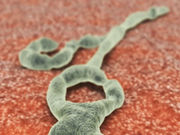Most patients received IV fluids and electrolyte supplementation, antibiotics, investigational tx
THURSDAY, Feb. 18, 2016 (HealthDay News) — Patients with Ebola virus disease (EVD) who received care in the United States and Europe show mortality of 18.5 percent, according to a study published in the Feb. 18 issue of the New England Journal of Medicine.
Timothy M. Uyeki, M.D., M.P.H., from the U.S. Centers for Disease Control and Prevention in Atlanta, and colleagues reviewed available clinical, laboratory, and virologic data from patients with laboratory-confirmed Ebola virus infection. Twenty-seven patients with EVD received care in U.S. and European hospitals from August 2014 through December 2015.
The researchers found that the most common signs and symptoms at the onset of illness were fatigue (80 percent) and fever or feverishness (68 percent). The predominant findings during the clinical course included diarrhea, hypoalbuminemia, hyponatremia, hypokalemia, hypocalcemia, and hypomagnesemia; 52 percent of patients had hypoxemia. Almost all patients received intravenous fluids and electrolyte supplementation, 33 percent received noninvasive or invasive mechanical ventilation, and 19 percent received continuous renal-replacement therapy. Eighty-one and 85 percent, respectively, received empirical antibiotics and investigational therapies. The median time from symptom onset to viremia clearance was 17.5 days. Five patients died, corresponding to a mortality rate of 18.5 percent.
“Close monitoring and aggressive supportive care that included intravenous fluid hydration, correction of electrolyte abnormalities, nutritional support, and critical care management for respiratory and renal failure were needed; 81.5 percent of these patients who received this care survived,” the authors write.
Copyright © 2016 HealthDay. All rights reserved.








